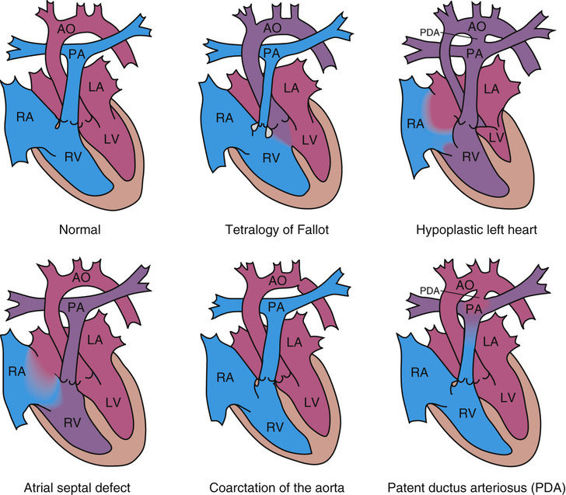
Certain isolated CHDs are inherited as multifactorial traits. Until more is known, the figures shown in Table 8-7 can be used as estimates of the recurrence risk for flow lesions in first-degree relatives. There is, however, a rapid falloff in risk (to levels not much higher than the population risk) in second- and third-degree relatives of index patients with flow lesions. Similarly, relatives of index patients with types of CHDs other than flow lesions can be offered reassurance that their risk is no greater than that of the general population. For further reassurance, many CHDs can now be assessed prenatally by ultrasonography (see Chapter 17).
Neuropsychiatric Disorders
Mental illnesses are some of the most common and perplexing of human diseases, affecting 4% of the human population worldwide. The annual cost in medical care and social services exceeds $150 billion in the United States alone. Among the most severe of the mental illnesses are schizophrenia and bipolar disease (manic-depressive illness).
Schizophrenia affects 1% of the world’s population. It is a devastating psychiatric illness, with onset commonly in late adolescence or young adulthood, and is characterized by abnormalities in thought, emotion, and social relationships, often associated with delusional thinking and disordered mood. A genetic contribution to schizophrenia is supported by both twin and family aggregation studies. MZ concordance in schizophrenia is estimated to be 40% to 60%; DZ concordance is 10% to 16%. The recurrence risk ratio is elevated in first- and second-degree relatives of schizophrenic patients (Table 8-8).
TABLE 8-8
Recurrence Risks and Relative Risk Ratios in Schizophrenia Families
| Relation to Individual Affected by Schizophrenia | Recurrence Risk (%) | λr |
| Child of two schizophrenic parents | 46 | 23 |
| Child | 9-16 | 11.5 |
| Sibling | 8-14 | 11 |
| Nephew or niece | 1-4 | 2.5 |
| Uncle or aunt | 2 | 2 |
| First cousin | 2-6 | 4 |
| Grandchild | 2-8 | 5 |
Although there is considerable evidence of a genetic contribution to schizophrenia, only a subset of the genes and alleles that predispose to the disease has been identified to date. A major exception is the small percentage (<2%) of all schizophrenia that is found in individuals with interstitial deletions of particular chromosomes, such as the 22q11 deletion responsible for the velocardiofacial syndrome. It is estimated that 25% of patients with 22q11 deletions develop schizophrenia, even in the absence of many or most of the other physical signs of the syndrome. The mechanism by which a deletion of 3 Mb of DNA on 22q11 (see Fig. 6-5) causes mental illness in patients with this syndrome is unknown. Chromosomal microarrays have been used to scan the entire genome for other deletions and duplications, many too small to be detectable by standard cytogenetic approaches, as introduced in Chapter 5. These studies have revealed numerous deletions and duplications (copy number variants [CNVs]) throughout the genome in both normal individuals and individuals with a variety of psychiatric and neurodevelopmental disorders (see Chapter 6). In particular, small (1- to 1.5-Mb) interstitial deletions at 1q21.1, 15q11.2, and 15q13.3 have been implicated repeatedly in a small fraction of patients with schizophrenia. For the vast majority of patients with schizophrenia, however, genetic lesions are not known, and counseling therefore relies on empirical risk figures (see Table 8-8).
Bipolar disease is predominantly a mood disorder in which episodes of mood elevation, grandiosity, high-risk dangerous behavior, and inflated self-esteem (mania) alternate with periods of depression, decreased interest in what are normally pleasurable activities, feelings of worthlessness, and suicidal thinking. The prevalence of bipolar disease is 0.8%, approximately equal to that of schizophrenia, with a similar age at onset. The seriousness of this condition is underscored by the high (10% to 15%) rate of suicide in affected patients.
A genetic contribution to bipolar disease is strongly supported by twin and family aggregation studies. MZ twin concordance is 40% to 60%; DZ twin concordance is 4% to 8%. Disease risk is also elevated in relatives of affected individuals (Table 8-9). One striking aspect of bipolar disease in families is that the condition has variable expressivity; some members of the same family demonstrate classic bipolar illness, others have depression alone (unipolar disorder), and others carry a diagnosis of a psychiatric syndrome that involves both thought and mood (schizoaffective disorder). Even less is known about genes and alleles that predispose to bipolar disease than is known for schizophrenia; in particular, although an increase in de novo deletions or duplications has been identified in bipolar psychosis, recurrent CNVs involving particular regions of the genome have not been identified. Counseling therefore typically relies on empirical risk figures (see Table 8-9).
TABLE 8-9
Recurrence Risks and Relative Risk Ratios in Bipolar Disorder Families
| Relation to Individual Affected with Bipolar Disease | Recurrence Risk (%)* | λr |
| Child of two parents with bipolar disease | 50-70 | 75 |
| Child | 27 | 34 |
| Sibling | 20-30 | 31 |
| Second-degree relative | 5 | 6 |
